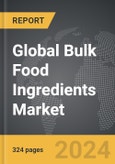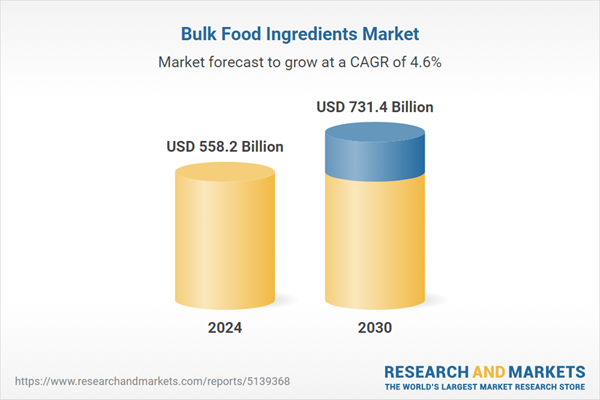The global market for Bulk Food Ingredients was valued at US$558.2 Billion in 2024 and is projected to reach US$731.4 Billion by 2030, growing at a CAGR of 4.6% from 2024 to 2030. This comprehensive report provides an in-depth analysis of market trends, drivers, and forecasts, helping you make informed business decisions. The report includes the most recent global tariff developments and how they impact the Bulk Food Ingredients market.
Segments: Type (Secondary, Primary).
Geographic Regions/Countries: World; United States; Canada; Japan; China; Europe (France; Germany; Italy; United Kingdom; Spain; Russia; and Rest of Europe); Asia-Pacific (Australia; India; South Korea; and Rest of Asia-Pacific); Latin America (Argentina; Brazil; Mexico; and Rest of Latin America); Middle East (Iran; Israel; Saudi Arabia; United Arab Emirates; and Rest of Middle East); and Africa.
The analysts continuously track trade developments worldwide, drawing insights from leading global economists and over 200 industry and policy institutions, including think tanks, trade organizations, and national economic advisory bodies. This intelligence is integrated into forecasting models to provide timely, data-driven analysis of emerging risks and opportunities.
Global Bulk Food Ingredients Market - Key Trends and Drivers Summarized
What Are Bulk Food Ingredients and Why Are They Crucial to the Global Food Industry?
Bulk food ingredients refer to raw or minimally processed materials that are supplied in large quantities to food manufacturers and processors for the production of a wide range of food products. These ingredients include grains, spices, sugar, dried fruits, dairy powders, oils, and more. Bulk food ingredients serve as the foundation for the food industry, ensuring that manufacturers have the necessary components to create everything from baked goods and snacks to beverages and ready-to-eat meals. Unlike retail food products sold directly to consumers, bulk food ingredients are purchased in larger volumes, allowing for cost efficiencies and streamlined manufacturing processes. These ingredients are vital to maintaining the continuous operation of the global food supply chain, as they enable manufacturers to meet the growing demand for processed and packaged foods while maintaining quality and safety standards. The ability to buy and store these ingredients in bulk also reduces overall production costs and minimizes the frequency of supply chain disruptions, making bulk food ingredients indispensable for large-scale food production.How Are Bulk Food Ingredients Used Across Different Segments of the Food Industry?
Bulk food ingredients are used extensively across various segments of the food industry, playing a critical role in the production of numerous consumer goods. In the bakery and confectionery sector, for example, bulk ingredients such as flour, sugar, cocoa, and oils are essential for producing items like bread, cakes, and chocolates in large volumes. These ingredients are sourced from suppliers in bulk quantities to ensure consistency in flavor and texture, while also reducing production costs for manufacturers. In the beverage industry, bulk ingredients such as fruit concentrates, sweeteners, and flavorings are crucial for creating sodas, juices, and alcoholic beverages. Similarly, in the dairy industry, bulk supplies of milk powder, whey, and cheese are used for producing a wide range of products, from infant formula to processed cheese. The snack food sector also heavily relies on bulk ingredients like grains, nuts, seeds, and seasonings to manufacture popular items like chips, trail mixes, and crackers. Moreover, in the prepared meals and convenience food industry, bulk ingredients enable the mass production of sauces, frozen meals, and canned goods, ensuring that these products are consistently available on supermarket shelves. Across all these segments, the use of bulk food ingredients is critical to maintaining efficient, large-scale food production and meeting consumer demands in a competitive marketplace.What Technological Innovations Are Shaping the Bulk Food Ingredients Market?
The bulk food ingredients market is being transformed by several technological advancements that are improving efficiency, sustainability, and quality control. One of the most significant innovations is the adoption of automated systems in ingredient processing, which allows for more precise measurements and faster handling of bulk materials. Automation in food manufacturing facilities helps streamline processes like sorting, mixing, and packaging, reducing human error and improving productivity. This, in turn, reduces the overall cost of food production while ensuring that large volumes of food ingredients are processed quickly and accurately. Another key advancement is the development of better storage solutions for bulk ingredients, including temperature-controlled environments and moisture-resistant packaging. These innovations help preserve the freshness and quality of ingredients like grains, dairy, and spices, which are prone to spoilage or contamination when stored improperly. The use of advanced sensors and monitoring systems is also becoming more common in bulk food ingredient handling, allowing for real-time tracking of environmental conditions during transport and storage. Additionally, traceability technology, including blockchain, is being integrated into the supply chain to ensure transparency in sourcing and handling. This is particularly important for food safety and regulatory compliance, as it allows manufacturers to trace ingredients back to their origin in case of contamination or quality issues. These technological advancements are reshaping how bulk food ingredients are processed, stored, and monitored, ensuring a more efficient and reliable global food supply chain.What Are the Major Factors Driving the Growth in the Bulk Food Ingredients Market?
The growth in the bulk food ingredients market is driven by several factors, reflecting changes in consumer behavior, industry demands, and technological advancements. One of the primary drivers is the increasing global demand for processed and convenience foods, driven by urbanization, rising incomes, and changing lifestyles. As more consumers seek ready-to-eat meals, snacks, and beverages, food manufacturers are scaling up production, creating a higher demand for bulk food ingredients that allow them to produce large quantities efficiently. Additionally, the growing emphasis on health and wellness is prompting manufacturers to incorporate more natural, organic, and minimally processed bulk ingredients into their products. This trend is driving demand for whole grains, plant-based proteins, and organic sweeteners, as consumers increasingly seek healthier alternatives to conventional processed foods. Another important growth driver is the expansion of the food and beverage industry in emerging markets, where rising populations and income levels are leading to increased consumption of packaged and processed foods. As food manufacturers establish operations in these regions, the need for bulk ingredients to support large-scale production is growing rapidly. Sustainability is also playing a critical role in the growth of the bulk food ingredients market. Food manufacturers are seeking sustainable sourcing practices and supply chain transparency to meet consumer demand for ethically produced goods. Bulk food ingredients, which often offer lower environmental impact due to more efficient shipping and reduced packaging waste, are aligning with these sustainability goals. Moreover, technological advancements in food preservation, packaging, and logistics are enabling the safe and efficient handling of bulk food ingredients across long distances, further driving market expansion.Report Scope
The report analyzes the Bulk Food Ingredients market, presented in terms of units. The analysis covers the key segments and geographic regions outlined below.Segments: Type (Secondary, Primary).
Geographic Regions/Countries: World; United States; Canada; Japan; China; Europe (France; Germany; Italy; United Kingdom; Spain; Russia; and Rest of Europe); Asia-Pacific (Australia; India; South Korea; and Rest of Asia-Pacific); Latin America (Argentina; Brazil; Mexico; and Rest of Latin America); Middle East (Iran; Israel; Saudi Arabia; United Arab Emirates; and Rest of Middle East); and Africa.
Key Insights:
- Market Growth: Understand the significant growth trajectory of the Secondary Ingredients segment, which is expected to reach US$486.4 Billion by 2030 with a CAGR of a 4.8%. The Primary Ingredients segment is also set to grow at 4.3% CAGR over the analysis period.
- Regional Analysis: Gain insights into the U.S. market, valued at $146.0 Billion in 2024, and China, forecasted to grow at an impressive 7.2% CAGR to reach $160.8 Billion by 2030. Discover growth trends in other key regions, including Japan, Canada, Germany, and the Asia-Pacific.
Why You Should Buy This Report:
- Detailed Market Analysis: Access a thorough analysis of the Global Bulk Food Ingredients Market, covering all major geographic regions and market segments.
- Competitive Insights: Get an overview of the competitive landscape, including the market presence of major players across different geographies.
- Future Trends and Drivers: Understand the key trends and drivers shaping the future of the Global Bulk Food Ingredients Market.
- Actionable Insights: Benefit from actionable insights that can help you identify new revenue opportunities and make strategic business decisions.
Key Questions Answered:
- How is the Global Bulk Food Ingredients Market expected to evolve by 2030?
- What are the main drivers and restraints affecting the market?
- Which market segments will grow the most over the forecast period?
- How will market shares for different regions and segments change by 2030?
- Who are the leading players in the market, and what are their prospects?
Report Features:
- Comprehensive Market Data: Independent analysis of annual sales and market forecasts in US$ Million from 2024 to 2030.
- In-Depth Regional Analysis: Detailed insights into key markets, including the U.S., China, Japan, Canada, Europe, Asia-Pacific, Latin America, Middle East, and Africa.
- Company Profiles: Coverage of players such as Archer Daniels Midland Company, Associated British Foods PLC, Cargill, Inc., Community Foods Limited, Dmh Ingredients, Inc. and more.
- Complimentary Updates: Receive free report updates for one year to keep you informed of the latest market developments.
Some of the 43 companies featured in this Bulk Food Ingredients market report include:
- Archer Daniels Midland Company
- Associated British Foods PLC
- Cargill, Inc.
- Community Foods Limited
- Dmh Ingredients, Inc.
- Dow, Inc.
- DuPont de Nemours, Inc.
- EHL Ltd.
- Ingredion, Inc.
- Olam International Ltd.
- Tate & Lyle PLC
Tariff Impact Analysis: Key Insights for 2025
Global tariff negotiations across 180+ countries are reshaping supply chains, costs, and competitiveness. This report reflects the latest developments as of April 2025 and incorporates forward-looking insights into the market outlook.The analysts continuously track trade developments worldwide, drawing insights from leading global economists and over 200 industry and policy institutions, including think tanks, trade organizations, and national economic advisory bodies. This intelligence is integrated into forecasting models to provide timely, data-driven analysis of emerging risks and opportunities.
What’s Included in This Edition:
- Tariff-adjusted market forecasts by region and segment
- Analysis of cost and supply chain implications by sourcing and trade exposure
- Strategic insights into geographic shifts
Buyers receive a free July 2025 update with:
- Finalized tariff impacts and new trade agreement effects
- Updated projections reflecting global sourcing and cost shifts
- Expanded country-specific coverage across the industry
Table of Contents
I. METHODOLOGYII. EXECUTIVE SUMMARY2. FOCUS ON SELECT PLAYERSIII. MARKET ANALYSISIV. COMPETITION
1. MARKET OVERVIEW
3. MARKET TRENDS & DRIVERS
4. GLOBAL MARKET PERSPECTIVE
UNITED STATES
CANADA
JAPAN
CHINA
EUROPE
FRANCE
GERMANY
ITALY
UNITED KINGDOM
SPAIN
RUSSIA
REST OF EUROPE
ASIA-PACIFIC
AUSTRALIA
INDIA
SOUTH KOREA
REST OF ASIA-PACIFIC
LATIN AMERICA
ARGENTINA
BRAZIL
MEXICO
REST OF LATIN AMERICA
MIDDLE EAST
IRAN
ISRAEL
SAUDI ARABIA
UNITED ARAB EMIRATES
REST OF MIDDLE EAST
AFRICA
Companies Mentioned (Partial List)
A selection of companies mentioned in this report includes, but is not limited to:
- Archer Daniels Midland Company
- Associated British Foods PLC
- Cargill, Inc.
- Community Foods Limited
- Dmh Ingredients, Inc.
- Dow, Inc.
- DuPont de Nemours, Inc.
- EHL Ltd.
- Ingredion, Inc.
- Olam International Ltd.
- Tate & Lyle PLC
Table Information
| Report Attribute | Details |
|---|---|
| No. of Pages | 324 |
| Published | April 2025 |
| Forecast Period | 2024 - 2030 |
| Estimated Market Value ( USD | $ 558.2 Billion |
| Forecasted Market Value ( USD | $ 731.4 Billion |
| Compound Annual Growth Rate | 4.6% |
| Regions Covered | Global |









